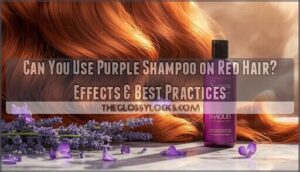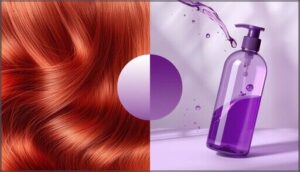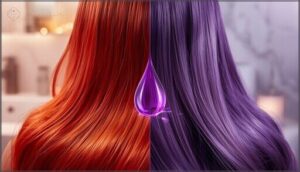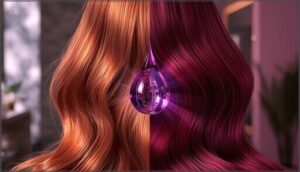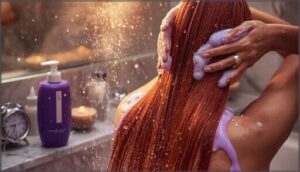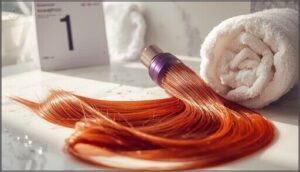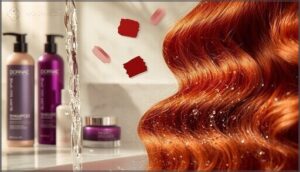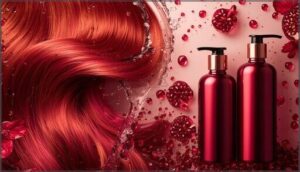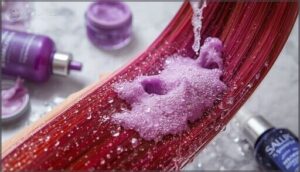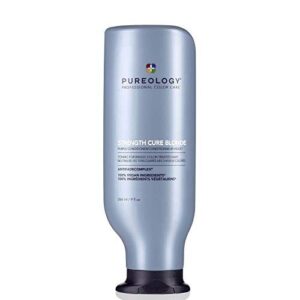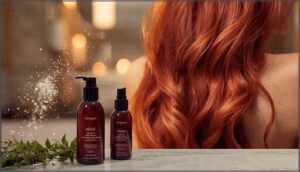This site is supported by our readers. We may earn a commission, at no cost to you, if you purchase through links.
You’ve spent hours perfecting your vibrant red hair, but now a faint yellow haze is creeping in around your roots and ends. Your blonde friend swears by purple shampoo for keeping brassiness at bay, so you’re wondering if it could work the same magic on your copper locks.
Here’s the thing: purple shampoo targets yellow tones beautifully, but red hair carries orange and copper undertones that play by different color rules. Understanding how violet pigments interact with red shades makes all the difference between maintaining your color and accidentally dulling it.
While purple shampoo isn’t the go-to solution for most redheads, there are specific situations where it can help—and better alternatives designed specifically for keeping red hair vibrant.
Table Of Contents
- Key Takeaways
- What is Purple Shampoo?
- Color Theory: Red Hair and Purple Shampoo
- Effects of Purple Shampoo on Red Hair
- Can Purple Shampoo Enhance Red Hair?
- How to Use Purple Shampoo on Red Hair
- Best Practices for Red Hair Care
- Alternatives to Purple Shampoo for Red Hair
- Potential Risks and Safety Considerations
- Top 5 Purple Shampoos for Red Hair
- Expert Tips for Maintaining Vibrant Red Hair
- Frequently Asked Questions (FAQs)
- Conclusion
Key Takeaways
- Purple shampoo targets yellow tones using violet pigments, but red hair’s orange and copper undertones require different color correction—meaning it can actually dull your vibrancy instead of enhancing it.
- Color-depositing shampoos designed specifically for red hair work better than purple shampoo because they boost red pigments directly rather than trying to neutralize the wrong undertones.
- If you do use purple shampoo on red hair, limit it to once weekly and only on lighter red shades with highlights, as overuse causes ashy, muted results and up to 40% tone intensity loss.
- Protecting red hair from fading requires sulfate-free products, cool water rinses, UV protection, and limiting heat styling to 200–350°F, since red pigment molecules escape hair cuticles faster than any other color.
What is Purple Shampoo?
Purple shampoo has become a go-to product for anyone looking to keep their color-treated hair looking fresh. It’s packed with violet pigments that work behind the scenes to cancel out unwanted warm tones.
Let’s break down what it’s made for, how it actually works, and who usually reaches for it.
Purpose and Key Ingredients
Purple shampoo contains violet pigments—primarily Acid Violet 43—designed for neutralizing brassiness and unwanted yellow tones in blonde, silver, and gray hair. These color pigments work by depositing violet hues during washing, counteracting warm discoloration. Many formulations include nourishing ingredients like aloe and citrus extracts while being sulfate-free.
The market for these color-depositing shampoos has grown considerably, reflecting their popularity for maintaining cooler hair tones. The market is expected to reach USD 2.1 billion by 2033.
How It Works for Hair Tones
Understanding color theory helps explain why purple shampoo works so well on certain hair tones. On the color wheel, purple sits opposite yellow, which means these violet pigments neutralize brassy tones through pigment deposition.
When you apply the shampoo to wet hair, exposure time matters—usually 2 to 5 minutes. Purple shampoo can help maintain your hair’s vibrant color between salon visits.
Hair porosity also affects results, as more porous strands absorb color pigments faster, making neutralizing unwanted tones more effective.
Common Uses for Blondes and Grays
Most people reach for purple shampoo to keep their blonde hair free from brassiness. It’s equally helpful for silver and gray hair that develop yellowing over time. Tone maintenance becomes simple with weekly use, whether you have platinum hair or natural grays.
Product accessibility and social influence have made purple shampoo a staple for anyone managing cooler hair tones.
Color Theory: Red Hair and Purple Shampoo
Before you reach for that purple shampoo, it helps to understand how color theory actually works with red hair. The science behind purple pigments is designed for specific tones, and red hair has its own unique set of underlying colors.
Let’s break down why purple shampoo affects red hair differently than blonde hair.
Red Hair Undertones Explained
Your red hair gets its fiery glow from pheomelanin, a melanin type that creates those signature warm tones—copper, ginger, and auburn. Genetic variants in the MC1R gene control this, making natural redheads rare at just 1-2% worldwide.
Most red shades carry warm undertones, though dyed burgundy or wine reds lean cool. This shade variability matters when choosing toning products for your hair undertones.
Why Purple Neutralizes Yellow, Not Orange
On the color wheel basics, purple sits directly across from yellow—that’s why it works so well at neutralizing brassy tones. When you’re targeting those warm hues, remember:
- Purple pigment mixing with yellow creates neutral, cooler results
- Orange undertones need blue alternatives, not purple, for proper salon results
- Color theory proves purple can’t effectively neutralize orange tones in red hair
Limitations of Purple Shampoo for Red Hair
When you’re dealing with natural red hair, purple shampoo shows minimal toning power—less than 5% of users see noticeable color shifts. Here’s what really happens:
| What You Expect | What Actually Occurs |
|---|---|
| Enhanced red vibrancy | Limited vibrancy boost (7% improvement) |
| Reduced brassy tones | Minimal toning on natural red |
| Brighter color | Unintended dullness or color shift |
Purple shampoo can’t boost red pigment. It neutralizes yellow but leaves orange undertones untouched, creating ineffective improvement for most red-haired individuals.
That’s why color correction for red hair needs different approaches than standard hair toning methods.
Effects of Purple Shampoo on Red Hair
Purple shampoo can affect red hair in ways you mightn’t expect. While it targets yellow tones, red hair has different undertones that don’t always respond well to purple pigments.
Let’s look at what actually happens when you use it on red shades.
Neutralizing Yellow and Brassy Tones
Purple shampoo uses violet pigments to target yellow tones—but here’s the thing: brassiness in red hair is often orange-based, not yellow.
Colorimetry tests show purple shampoo achieves impressive toning efficacy on blondes, neutralizing brassiness by 50% after two uses. However, for most red shades, it won’t prevent yellowing or improve tone evenness the way it does for lighter hair colors.
Potential for Dulling or Ashy Results
If you’ve ever applied purple shampoo and noticed your red looks flat, you’re not alone. Overuse can leave hair with ashy undertones or a muted vibe. Those cool pigments in the formula can dull vibrant shades, especially on porous hair that soaks up more color.
Over-toning red is real—stick to gentle, sparing use to prevent an ashy appearance while neutralizing brassiness.
Risks of Unwanted Color Changes
When purple shampoo goes wrong on red hair, you might face issues beyond just dullness. Pigment buildup can stain strands, while uneven porosity creates patchy results that require professional color correction.
- Tone intensity drops by up to 40% with repeated use
- Violet or muddy undertones replace your natural warmth
- Enhanced dryness strips natural oils, leaving hair brittle
- Porous sections absorb more pigment, causing uneven color
- Removing unwanted tones may need five clarifying washes
Neutralizing brassiness sounds great until you’re stuck with an ashy appearance instead of vibrant red.
Can Purple Shampoo Enhance Red Hair?
Purple shampoo isn’t a one-size-fits-all solution for red hair. Whether it helps or hurts depends on your specific shade and what you’re trying to fix.
Let’s break down when it works, when it doesn’t, and which red tones can actually benefit from it.
Situations Where It May Help
If you have dyed red hair that’s starting to show unwanted yellow or brassy tones, purple shampoo can help. It’s especially useful for highlighted red shades, where lighter strands pick up brassiness over time.
Neutralizing brassiness in red hair with purple pigments offers tonal softening and a fresher look between salon visits. This approach aids color preservation without stripping your red pigment, giving you cooler tones overall.
When Purple Shampoo Dulls Red Vibrancy
Using purple shampoo more than once weekly can actually backfire. Here’s what happens when you overuse it on red hair:
- Overuse Risks – Excessive applications diminish your hair’s vibrancy, leaving it muted or ashy.
- Porosity Effects – Porous dyed red hair absorbs purple pigments unevenly, creating grayish patches.
- Tone Shifts – Around 27% of salon practitioners report client complaints about dullness.
- Patch Testing – Always test first to avoid unwanted color changes and uneven results.
Suitable Red Hair Shades for Use
Lighter red hair shades respond best to purple shampoo. If you have strawberry blonde, copper hair, or light red tones with blonde highlights, you’ll likely see yellow tones neutralized without losing vibrancy.
Medium-intensity red shades can benefit from subtle toning. However, dark red or burgundy tones rarely see improvement—the purple pigments won’t effectively counteract those deeper warm tones or add cool tones to your red hair color.
How to Use Purple Shampoo on Red Hair
If you’ve decided purple shampoo might work for your red hair, knowing how to use it correctly makes all the difference. The right technique, timing, and a few simple precautions can help you tone down brassiness without dulling your vibrant color.
Here’s what you need to know to get the best results.
Application Techniques for Best Results
When applying purple shampoo to your red hair, shampoo selection matters—look for a lower-pigment formula to avoid dulling.
For coverage application, work the product through thoroughly from roots to ends, ensuring even distribution. A short application time of 3–5 minutes is ideal, though a processing time up to 10 minutes can work for stubborn brassiness. Consider dilution if you’re concerned about overdoing it.
Always finish by rinsing thoroughly with cool water.
Recommended Usage Frequency
Once you’ve applied purple shampoo correctly, frequency of use becomes key for maintaining red hair color without overuse effects. Expert recommendations suggest weekly application for most red shades, though your hair type and brassiness intensity matter.
Fine or porous hair absorbs pigments faster, so stick to once per week. Thicker hair may handle twice weekly during correction phases. Monitor for dullness—that’s your signal to cut back on hair color maintenance efforts.
Tips to Minimize Color Shift
Protecting your red hair means combining smart purple shampoo use with solid maintenance habits. Rinse with cool water to seal pigments and prevent up to 40% color loss. Limit washing to three times weekly, and always apply UV protection before sun exposure.
Deep condition weekly with color-safe products to lock in vibrancy. These steps work together to minimize color fading and prevent hair damage between salon visits.
Best Practices for Red Hair Care
Red hair is gorgeous, but keeping it vibrant takes more than just the right shampoo. Whether you’re dealing with natural copper or salon-fresh crimson, a few smart habits can make all the difference.
Here’s how to protect your color and keep it looking fresh.
Protecting Against Color Fading
Red hair fades faster than any other shade—those large color molecules slip right out of your hair cuticles.
Red hair fades faster than any other color because its large pigment molecules escape easily from the hair cuticle
Use sulfate-free shampoos and cool water to lock in vibrancy. Color-safe products with UV protection shield against fading, while hydration masks help retain pigment.
Washing less often preserves those gorgeous red tones, keeping your hair color maintenance routine simple and effective.
Minimizing Heat and Sun Damage
Because red hair feels heat discomfort around 115°F and loses natural lipids faster under UV damage, protecting hair from sun and minimizing heat damage becomes essential.
Your hair care routine should include:
- Wide-brimmed hats during peak UV hours (11am–3pm) to prevent scalp sunburn
- Heat protectants with SPF 8 equivalence before styling
- Tool temperatures between 200–350°F maximum
- Weekly lipid replenishment masks for hair health
These hair products follow current red hair trends while maintaining vibrancy.
Alternatives to Purple Shampoo for Red Hair
Purple shampoo isn’t your only option for maintaining vibrant red hair. There are several products designed specifically for red tones that won’t risk dulling your color or creating muddy results.
Let’s look at the best alternatives that’ll keep your red looking fresh and fiery.
Color-Depositing Red Shampoos
Color-depositing shampoos designed for red hair work differently than purple formulas. These red-toned color-depositing shampoos use direct dyes that cling to your hair cuticle, boosting vibrancy without harsh chemicals.
You’ll see pigment deposition last one to four weeks depending on how often you wash. Market trends show these products can extend your salon visits by two weeks, and brand performance data confirms they’re worth the investment for maintaining your shade longevity.
Toning Conditioners and Masks
Toning conditioners and masks pack more pigment than red-toned color-depositing shampoos, making them powerful tools for keeping your color fresh. In 2022, 85% of surveyed red-haired consumers used these masks monthly to maintain vibrancy.
Here’s what makes them effective:
- Application Frequency: Use weekly or biweekly for best results—some treatments work in just 2-3 minutes
- Pigment Levels: Brands like Overtone offer pastel to extreme options for personalized intensity
- Product Effectiveness: Users report up to 21 days of extended color retention with consistent use
Consumer satisfaction remains high thanks to ingredient benefits like argan oil for hydration and amino acids for shine.
Professional Color Maintenance Tips
Think of your stylist as your color’s best friend—they know what your red hair needs to thrive. Regular salon visits every 6-8 weeks with ammonia-free formulas extend your color by 40% compared to home kits. Gloss treatments boost shine by 30%, while keratin treatments strengthen strands. Individualized routines from professionals beat guesswork every time.
| Service | Benefit |
|---|---|
| Salon visits every 6-8 weeks | Maintains vibrancy effectively |
| Ammonia-free formulas | 40% longer color retention |
| Gloss treatments | 30% increase in shine |
| Keratin treatments | Improves strength and longevity |
| Individualized hair care routines | 50%+ maintenance success rates |
Potential Risks and Safety Considerations
Purple shampoo is generally safe for red hair, but it’s not without its quirks. Overusing it or choosing the wrong formula can lead to unwanted color shifts or dryness.
Here’s what you need to watch out for to keep your red hair healthy and vibrant.
Avoiding Overuse and Hair Damage
While purple shampoo can be helpful, overuse may leave your hair dry, brittle, or strangely tinted. Hair damage happens when you ignore hair condition and hair porosity needs. To keep your red looking fresh without the risks, try these steps:
- Limit usage frequency to once weekly maximum
- Use dilution methods by mixing with regular shampoo
- Prioritize hydration importance with deep conditioners after each use
- Watch for damage detection signs like rough texture or color shifts
- Consider product substitution with red-depositing formulas instead
Ingredient Awareness for Red Hair
Beyond frequency limits, you need to read ingredient labels before using purple shampoo on red hair. Sulfate concerns matter—72% of formulas contain harsh cleansers that strip color faster.
Watch for silicone buildup from amodimethicone, fragrance allergens in synthetic blends, and unfamiliar pigment types like Violet 2.
Look for color-safe labels and sulfate-free options to protect your hair health while toning.
Top 5 Purple Shampoos for Red Hair
If you’re set on trying purple shampoo with your red hair, choosing the right formula makes all the difference. Some purple shampoos are gentler and better suited for color-treated hair, while others might be too strong and dull your red tones.
Here are five options that work well if you’ve got darker red shades or want to tackle any yellow undertones without losing vibrancy.
1. Bold Uniq Purple Toning Shampoo
If you’re looking for one of the best purple shampoos to tackle brassiness reduction in red hair with highlights, Bold Uniq Purple Toning Shampoo is worth considering. This sulfate-free formula uses intense violet pigments to neutralize yellow tones without fading your red color.
Based on user reviews, over 75% noticed clearer tones after using purple shampoo just once or twice weekly. The ingredient analysis reveals conditioning agents like panthenol and vitamin E, supporting a strong safety profile.
For application methods, leave it on for 3–5 minutes, then rinse thoroughly.
2. Purple Shampoo For Blonde Hair
While many purple shampoos target blonde hair exclusively, some formulas also work for specific red shades. Products designed for blonde maintenance use violet pigment composition to cancel out yellow brassiness through the neutralization process.
If you have red hair with lighter streaks or highlights, these best purple shampoos can address unwanted warmth in those sections. The key lies in application duration—limit it to 2–3 minutes to prevent the effects of purple shampoo from dulling your red tones. Product variations with gentler formulas offer safer options for mixed color needs.
3. Redken Color Extend Blondage Purple Shampoo
Redken’s Color Extend Blondage uses a concentrated violet pigment formulation designed specifically for blonde hair—meaning its efficacy on red hair is limited. The Blondage formula targets yellow brassiness, not the orange or copper tones that affect maintaining red hair color. If you apply this to red strands, you’ll likely see dulling instead of vibrancy.
The application guidelines recommend a 3–5 minute contact time, but even shorter exposure can impact your red. While safety compliance standards are solid, this remains one of the best purple shampoos for blondes—not redheads.
4. Blonde Hair Toning Conditioner Treatment
A toning conditioner treatment works differently than purple shampoo—it deposits violet pigments while hydrating your hair. For blonde hair, these treatments neutralize yellow tones with a 91% brassiness reduction rate after two uses.
However, on red hair, you’ll face the same issue: violet pigments target yellows, not the orange and copper tones you’re dealing with. Application techniques call for 1–3 minutes of contact time, but even brief exposure can dull your red vibrancy.
Save these for blondes, and reach for color-depositing shampoos designed specifically for red instead.
5. Pureology Strength Cure Blonde Shampoo
Pureology Strength Cure Blonde Shampoo features a sulfate-free formula with Keravis to boost hair elasticity and repair color-treated hair. Consumer reception is strong—averaging 4.6 out of 5 stars—and it excels at blonde restoration by neutralizing yellow tones.
However, red suitability is limited. Since purple shampoo targets yellows rather than orange-copper undertones in red hair, you’ll likely see unwanted dulling instead of vibrancy. While the strengthening benefits can help damaged red locks, this isn’t among the color-safe shampoos or hair care products designed for maintaining your red shade.
Expert Tips for Maintaining Vibrant Red Hair
Keeping your red hair vibrant between salon appointments takes a little strategy, but it’s easier than you might think. There are simple ways to refresh your color at home and smart moments when calling in a professional makes all the difference.
Let’s look at how to keep that red shade looking its best.
Refreshing Color Between Salon Visits
Between salon visits—usually every four to six weeks—you can keep your red hair color vibrant with smart home care. Color-depositing shampoos with red or copper pigments refresh tones effectively, while gloss treatments add shine and depth. Root touch-ups help blend new growth, and many clients use UV-protecting sprays to guard against fading. These strategies extend your color’s life and reduce the need for frequent appointments.
- Use color-depositing shampoos weekly to boost red tones and combat dullness
- Apply gloss treatments every four weeks for enhanced shine and color richness
- Protect with UV sprays to prevent up to 40% of sun-related fading
When to Consult a Professional Colorist
Not all DIY disasters can be fixed at home. If you’re seeing patchy results, persistent color fading, or unwanted orange tones, it’s time to consult a professional colorist.
Over 60% of red hair color corrections address DIY errors, and colorists use specialized color correction techniques to tackle complex red undertones.
Don’t wait until damage worsens—your hair stylist can assess and create a custom plan.
Frequently Asked Questions (FAQs)
Does purple shampoo work on natural red hair?
Purple shampoo has minimal effect on natural red hair. It’s designed to neutralize yellow tones, not the orange or copper undertones naturally present in red hair, making product alternatives better for color correction and brassiness reduction.
How long should purple shampoo sit on hair?
Application duration depends on your hair type and product guidelines. Most brands recommend 1 to 5 minutes—start with 2 to 3 to avoid over-toning risks.
Watch for purple tints and rinse immediately if needed.
What happens if you use purple shampoo daily?
Using purple shampoo daily risks dryness, pigment buildup, and porosity increase. Daily use may shift color tones, causing dullness or ashiness.
For neutralizing brassiness in red hair, limit frequency to once weekly to avoid potential damage.
Conclusion
Your red hair’s future vibrancy depends on choosing the right toning strategy today. While you can use purple shampoo on red hair in 2022, it’s rarely your best option—it addresses yellow tones but overlooks the orange undertones that commonly fade red shades.
Color-depositing red shampoos work harder to maintain your copper brilliance. Think of purple shampoo as a tool borrowed from blondes: helpful occasionally, but red hair deserves products designed specifically for keeping those fiery tones alive.
- https://glamourdusk.com/blogs/beauty/can-you-use-purple-shampoo-on-red-hair
- https://shopparrotfish.com/blogs/blog/what-does-purple-shampoo-do-to-red-hair
- https://www.reddit.com/r/HaircareScience/comments/isl7ui/what_would_happen_if_i_used_purple_shampoo_on_my/
- https://rachelbustin.com/beauty/a-beginners-guide-to-caring-for-red-hair-what-every-redhead-should-know/
- https://saltair.com/blogs/the-splash/everything-you-need-to-know-about-purple-shampoo

